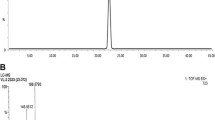Abstract
The Lactobacillus plantarum strain was isolated from grass silage that produces a broad spectrum of antifungal compound, active against food and feed-borne filamentous fungi in agar plate assay. Aspergillus fumigatus and Rhizopus stolonifer were the most sensitive among molds. No inhibitory activity could be detected against mold Penicillium roqueforti. Enhanced antifungal activity was observed at 30 °C in pH 6.5. Minimum inhibitory concentration values against fungal cultures were ranged from 6.5 to 12.0 mg/ml for commercial 3-phenyllactic acid. The production of antifungal compound phenyllactic acid (PLA), lactic acid, and acetic acid by L. plantarum strain was also investigated. Structure characterization of the antifungal compound was carried out by nuclear magnetic resonance spectroscopy, infrared spectroscopy, and gas chromatography. The produced compound (PLA) acted as a fungistatic and delayed the growth of a variety of fungal contaminants.



Similar content being viewed by others
References
Broberg, A., Jacobsson, K., Strom, K., & Schnurer, J. (2007). Metabolite profile of lactic acid bacteria in grass silage. Applied and Environmental Microbiology, 73(17), 5547–5552. doi:10.1128/AEM.02939-06.
Calo-Mata, P., Arlindo, S., Boehme, K., de Miguel, T., Pascoal, A., & Barros-Velazquez, J. (2008). Current applications and future trends of lactic acid bacteria and their bacteriocins for the biopreservation of aquatic food products. Food Bioprocess Technology, 1, 43–63. doi:10.1007/s11947-007-0021-2.
Caplice, E., & Fitzgerald, G. F. (1999). Food fermentations: Role of microorganisms in food production and preservation. International Journal of Food Microbiology, 50, 131–149. doi:10.1016/S0168-1605(99)00082-3.
Corcoran, B. M., Ross, R. P., Fitzgerald, G. F., & Stanton, C. (2004). Comparative survival of probiotic lactobacilli spray-dried in the presence of prebiotic substances. Journal of Applied Microbiology, 96(5), 1024–1039. doi:10.1111/j.1365-2672.2004.02219.x.
Corsetti, A., Gobebetti, M., Rossi, J., & Damiani, P. (1998). Antimold activity of sourdough lactic acid bacteria: Identification of a mixture of organic acids produced by Lactobacillus sanfrancisco CBI. Applied Microbiology and Biotechnology, 50, 253–256. doi:10.1007/s002530051285.
Daeschel, M. A. (1989). Antimicrobial substances from lactic acid bacteria for use as food preservatives. Food Technologist, 43, 164–167.
De Vuyst, L., & Vandamme, E. J. (1994). Bacteriocins of lactic acid bacteria. London, England: Blackie Academie & Professional.
Dieuleveux, V., Lemarinier, S., & Gueguan, M. (1998). Antimicrobial spectrum and target site of D-3-phenyl lactic acid. International Journal of Food Microbiology, 40, 177–183. doi:10.1016/S0168-1605(98)00031-2.
Gardiner, G. E., O’Sullivan, E., Kelly, J., Auty, M. A., Fitzgerald, G. F., Collins, J. K., et al. (2000). Comparative survival rates of human-derived probiotic Lactobacillus paracasei and L. salivarius strains during heat treatment and spray drying. Applied and Environmental Microbiology, 66(6), 2605–2612. doi:10.1128/AEM.66.6.2605-2612.2000.
Gibbs, P. A. (1987). Novel uses of lactic acid fermentation in food preservation. Journal of Applied Bacteriology, Symposium Supplement, pp. 51S–58S.
Gourama, H. (1997). Inhibition of growth and mycotoxin production of Penicillium by Lactobacillus species. Lebensmittel-Wissenschaft Technologie, 30, 279–283. doi:10.1006/fstl.1996.0183.
Heil, M., Prodebrad, F., Beck, T., Mogandl, A., Sewell, A. C., & Bohles, H. (1998). Enantio selective multidimensional gas chromatography spectrometry in the analysis of urinary organic acid. Journal of Chromatography, 714B, 119–126.
Klaenhammer, T. R. (1988). Bacteriocins of lactic acid bacteria. Biochimie, 70, 337–349. doi:10.1016/0300-9084(88)90206-4.
Lavermicocca, P., Valerio, F., Evidente, A., Lazzaroni, S., Corsetti, A., & Gobebetti, M. (2000). Purification and characterization of novel antifungal compounds from the sourdough Lactobacillus plantarum strain 21B. Applied and Environmental Microbiology, 66, 4084–4090. doi:10.1128/AEM.66.9.4084-4090.2000.
Legan, J. D. (1993). Mold spoilage of bread: the problem and some solutions. International Journal of Biodeterioration Biodegradation, 32, 33–53. doi:10.1016/0964-8305(93)90038-4.
Lindgren, S. E., & Dobrogosz, W. J. (1990). Antagonistic activities of lactic acid bacteria in food and feed fermentations. FEMS Microbiology Reviews, 87, 149–164. doi:10.1111/j.1574-6968.1990.tb04885.x.
Magnusson, J., & Schnurer, J. (2001). Lactobacillus coryniformis subsp. coryniformis strain Si3 produces a broad-spectrum proteinaceous antifungal compound. Applied and Environmental Microbiology, 67, 1–5. doi:10.1128/AEM.67.1.1-5.2001.
Niku-Paavola, M. L., Laitila, A., Mattila Sandholm, T., & Haikara, A. (1999). New types of antimicrobiol compounds produced by Lactobacillus plantarum. Journal of Applied Microbiology, 86, 29–35. doi:10.1046/j.1365-2672.1999.00632.x.
Okkers, D. J., Dicks, L. M. T., Silvester, M., Joubert, J. J., & Odendaal, H. J. (1999). Characterization of pentocin TV35b, a bacteriocin like peptide isolated from Lactobacillus pentosus with a fungistatic effect on Candida albicans. Journal of Applied Microbiology, 87, 726–734. doi:10.1046/j.1365-2672.1999.00918.x.
Ponte, J. G., & Tsen, C. C. (1987). Bakery products. In L. R. Beuchat (Ed.), Food and beverage mycology (pp. 233–267, 2nd ed.). New York: AVI/Van Nostrand Reinhold.
Rocken, W. (1996). Applied aspects of sourdough fermentation. Advance Food Science Technology, 18, 212–216.
Silva, J., Carvalho, A. S., Teixeira, P., & Gibbs, P. A. (2002). Bacteriocin production by spray-dried lactic acid bacteria. Letters in Applied Microbiology, 34(2), 77–81. doi:10.1046/j.1472-765x.2002.01055.x.
Sneath, P. H. A., Mair, N. S., Sharpe, N. E., & Holt, J. G. (1996). Bergey’s manual of systematic bacteriology, vol. 2 pp. 1219–1234. Baltimore, USA: Williams and Wilkins.
Spicher, G. (1983). Baked goods. In G. Reed (Ed.), Biotechnology. Food and feed productions with microorganisms, vol. 5 (pp. 1–80). Weinheim, Germany: Verlag Chemie.
Spicher, G. (1984). Die erreger der Schimmelbildung bei backawaren. 1. Mitt: die aufverpackten schinittbroten auftretenden schimmelpilze. Getreide Mehl Brot, 38, 77–80.
Stiles, M. E. (1996). Biopreservation by lactic acid bacteria. Antonie Van Leeuwenhoek, 70, 331–345. doi:10.1007/BF00395940.
Stroem, K., Sjogren, J., Broberg, A., & Schnurer, J. (2002). Lactobacillus plantarum Mi LAB 393 produces the antifungal cyclic dipeptides cyclo (L-Phe–L-Pro) and Cyclo (L-Phe-trans-4-OH-L-Pro) and phenyl lactic acid. Applied and Environmental Microbiology, 68, 4322–4327. doi:10.1128/AEM.68.9.4322-4327.2002.
Author information
Authors and Affiliations
Corresponding author
Rights and permissions
About this article
Cite this article
Prema, P., Smila, D., Palavesam, A. et al. Production and Characterization of an Antifungal Compound (3-Phenyllactic Acid) Produced by Lactobacillus plantarum Strain. Food Bioprocess Technol 3, 379–386 (2010). https://doi.org/10.1007/s11947-008-0127-1
Received:
Accepted:
Published:
Issue Date:
DOI: https://doi.org/10.1007/s11947-008-0127-1



